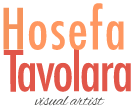SINGULAR SOLUTIONS TO COLLECTIVE PROBLEMS
Soluciones Singulares a Problemas Colectivos
2012
This work is the creative result that comes up from a profound introspection in which the artist relates different bodily states of emergency to Peruvian geographical areas. This exhibition introduces the series: “Violence / Ayacucho”, “Intoxication / Apurimac”, “Anguish /Lima”, “Fever / Cajamarca” , “Hunger / Huancavelica”, “Freeze / Puno”, and “Asphyxia/Amazonia”, to evoke the different crisis that these regions face. La obra de Hosefa, es el resultado creativo de una profunda introspección, en la cual relaciona estados corporales de emergencia con una región del Perú. Encontramos las series: Violencia/Ayacucho, Intoxicación/Apurimac, Angustia/Lima, Fiebre/Cajamarca, Hambre/Huancavelica, Friaje/Puno y Asfixia/Amazonía para evocar los problemas de crisis que enfrenta cada una de éstas regiones.
"In the words of Victor Vich: "my paintings immerse the viewers in the depths of the body". I agree with this comment. I was thinking of Lygia Clark's idea when she says that the work of art is a living body that acquires relevance when the viewer interacts with it. She also talks about the collective body. These two ideas led me to think that the house, the community, the region, the planet are the body. Our body is the place that gives us life and allows us to inhabit the world, but we do it through an essential act for survival: breathing. The territories of South America are threatened, and by thinking of them as bodies we can identify the difficulties they face. We become aware of feverish, intoxicated, violated bodies. All because of the actions of humanity that still breathes without respecting the territories that are mother earth. " - Hosefa Tavolara
“En palabras de Víctor Vich: “mis cuadros sumergen a los espectadores en las profundidades del cuerpo”. Coincido con este comentario. Pensaba en la idea de Lygia Clark cuando dice que la obra de arte es un cuerpo vivo que adquiere relevancia cuando el espectador interactúa con ella. Ella también habla del cuerpo colectivo. Éstas dos ideas me llevaron a pensar que la casa, la comunidad, la región, el planeta son el cuerpo. Nuestro cuerpo es el lugar que nos da la vida y nos permite habitar el mundo, pero lo hacemos a través de un acto esencial para la supervivencia: la respiración. Los territorios de América del Sur se encuentran amenazados, y al pensarlos como cuerpos podemos identificar las dificultades que enfrentan. Tomamos consciencia de cuerpos afiebrados, intoxicados, violentados. Todo por el accionar de la humanidad que aún respira sin respetar los territorios que son la madre tierra. “ - Hosefa Tavolara
VIOLENCE / VIOLENCIA AYACUCHO
BLANKET OF WORDS FROM THE SERIES: VIOLENCE IN AYACUCHO / MANTO DE PALABRAS DE LA SERIE: VIOLENCIA EN AYACUCHO. OIL ON CANVAS / Óleo sobre Lienzo. 4 paneles de 1.70 cm x 2.55 cm. ( 700cm x 255 cm)
FEVER / FIEBRE CAJAMARCA
FREEZE / FRIAJE PUNO
HUNGER / HAMBRE HUANCAVELICA
ASPHYXIA/ASFIXIA AMAZONIA
PERFORMANCE for the Exhibition Opening
PERFORMANCE PARA LA INAUGURACIÓN DE LA MUESTRA
VIOLENCE / VIOLENCIA AYACUCHO PERFORMANCE
Violence has been present in the life of the department of Ayacucho as a design. In a powerful and violent performance, the dancer Simone Mello, struggles, slips, falls, gets up and continues while "A Love Supreme", part III, by John Coltrane, gives no peace to the listener despite invoking a supreme love, as a metaphor for what happened to all those women who were systematically raped during the three decades of terrorism in Peru 1980-1990-2000 in Ayacucho.
La violencia ha estado presente en la vida del departamento de Ayacucho como un designio. En una potente y violenta performance, la bailarina Simone Mello, forcejea, resbala, cae, se levanta y continúa mientras suena “A Love Supreme”, parte III, de John Coltrane que no da paz al oyente a pesar de invocar un amor supremo, como una metáfora de lo que sucedió a todas las mujeres que fueron sistemáticamente violadas en Ayacucho durante las tres décadas de terrorismo en el Perú 1980-1990-2000.
ASPHYXIA / ASFIXIA AMAZONIA PERFORMANCE
It is the culminating performance of the exhibition. This series is inspired by a title of an art therapy proposal by artist Lygia Clark. The series is about the Amazon region of South America which represents a space that should be loved, respected and preserved by all the inhabitants of the earth. And this region is not being protected by the authorities of the respective countries Brazil and Peru. Artists from unite in a meditation to call the world's attention to the Amazon. (This series has inspired a project that is currently being worked on, entitled AMA- ZONAS).
Es la performance culminante de la exposición. Esta serie se inspira en un título de una propuesta de arteterapia de la artista Lygia Clark. La serie versa sobre la región de la Amazonía de América del Sur que representa un espacio que debería ser amado, respetado y preservado por todos los habitantes de la tierra. Y esta región no está siendo protegida por las autoridades de los respectivos países Brasil y Perú. Los artistas de ambos países nos unimos en una meditación para llamar la atención del mundo sobre la Amazonía. (Esta serie ha inspirado un proyecto que se está trabajando en la actualidad, titulado AMA- ZONAS).
(1). Lygia Clark The abandonment of art, 1948 – 1988. 33/38 / Respire comigo (Breath with me), 1966
Photographs by:/ Fotografías por: Paintings / Pinturas: Gonzalo Cáceres - Photographs by:/ Fotografías por: Performance: Luciana Queirolo Ll.




